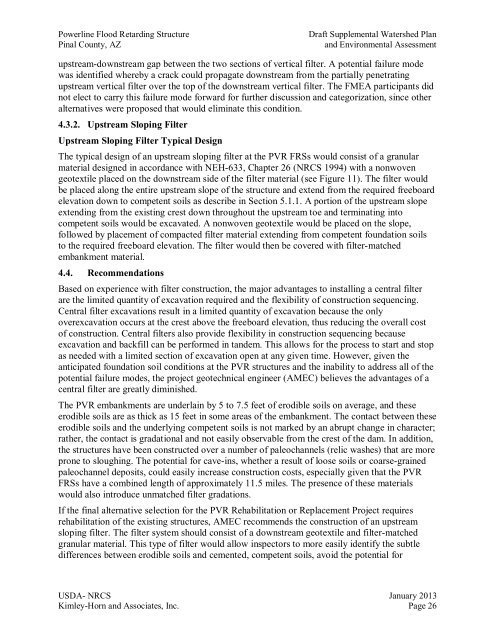Powerline Plan and Environ. Assessment Jan. 2013 - Flood Control ...
Powerline Plan and Environ. Assessment Jan. 2013 - Flood Control ...
Powerline Plan and Environ. Assessment Jan. 2013 - Flood Control ...
You also want an ePaper? Increase the reach of your titles
YUMPU automatically turns print PDFs into web optimized ePapers that Google loves.
<strong>Powerline</strong> <strong>Flood</strong> Retarding Structure<br />
Pinal County, AZ<br />
Draft Supplemental Watershed <strong>Plan</strong><br />
<strong>and</strong> <strong>Environ</strong>mental <strong>Assessment</strong><br />
upstream-downstream gap between the two sections of vertical filter. A potential failure mode<br />
was identified whereby a crack could propagate downstream from the partially penetrating<br />
upstream vertical filter over the top of the downstream vertical filter. The FMEA participants did<br />
not elect to carry this failure mode forward for further discussion <strong>and</strong> categorization, since other<br />
alternatives were proposed that would eliminate this condition.<br />
4.3.2. Upstream Sloping Filter<br />
Upstream Sloping Filter Typical Design<br />
The typical design of an upstream sloping filter at the PVR FRSs would consist of a granular<br />
material designed in accordance with NEH-633, Chapter 26 (NRCS 1994) with a nonwoven<br />
geotextile placed on the downstream side of the filter material (see Figure 11). The filter would<br />
be placed along the entire upstream slope of the structure <strong>and</strong> extend from the required freeboard<br />
elevation down to competent soils as describe in Section 5.1.1. A portion of the upstream slope<br />
extending from the existing crest down throughout the upstream toe <strong>and</strong> terminating into<br />
competent soils would be excavated. A nonwoven geotextile would be placed on the slope,<br />
followed by placement of compacted filter material extending from competent foundation soils<br />
to the required freeboard elevation. The filter would then be covered with filter-matched<br />
embankment material.<br />
4.4. Recommendations<br />
Based on experience with filter construction, the major advantages to installing a central filter<br />
are the limited quantity of excavation required <strong>and</strong> the flexibility of construction sequencing.<br />
Central filter excavations result in a limited quantity of excavation because the only<br />
overexcavation occurs at the crest above the freeboard elevation, thus reducing the overall cost<br />
of construction. Central filters also provide flexibility in construction sequencing because<br />
excavation <strong>and</strong> backfill can be performed in t<strong>and</strong>em. This allows for the process to start <strong>and</strong> stop<br />
as needed with a limited section of excavation open at any given time. However, given the<br />
anticipated foundation soil conditions at the PVR structures <strong>and</strong> the inability to address all of the<br />
potential failure modes, the project geotechnical engineer (AMEC) believes the advantages of a<br />
central filter are greatly diminished.<br />
The PVR embankments are underlain by 5 to 7.5 feet of erodible soils on average, <strong>and</strong> these<br />
erodible soils are as thick as 15 feet in some areas of the embankment. The contact between these<br />
erodible soils <strong>and</strong> the underlying competent soils is not marked by an abrupt change in character;<br />
rather, the contact is gradational <strong>and</strong> not easily observable from the crest of the dam. In addition,<br />
the structures have been constructed over a number of paleochannels (relic washes) that are more<br />
prone to sloughing. The potential for cave-ins, whether a result of loose soils or coarse-grained<br />
paleochannel deposits, could easily increase construction costs, especially given that the PVR<br />
FRSs have a combined length of approximately 11.5 miles. The presence of these materials<br />
would also introduce unmatched filter gradations.<br />
If the final alternative selection for the PVR Rehabilitation or Replacement Project requires<br />
rehabilitation of the existing structures, AMEC recommends the construction of an upstream<br />
sloping filter. The filter system should consist of a downstream geotextile <strong>and</strong> filter-matched<br />
granular material. This type of filter would allow inspectors to more easily identify the subtle<br />
differences between erodible soils <strong>and</strong> cemented, competent soils, avoid the potential for<br />
USDA- NRCS <strong>Jan</strong>uary <strong>2013</strong><br />
Kimley-Horn <strong>and</strong> Associates, Inc. Page 26













